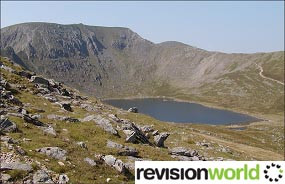Cirques, Corries or Cwms
Cirques (France), corries (Scotland) or cwms (Wales) are glacial hollows with a very steep backwall and a basin that may contain a lake or tarn when the glacier retreats and melts.
Snow collects in pre-glacial hollows, particularly on sheltered, north-facing slopes and a combination of freeze-thaw weathering, solifluction flow and summer meltwater activity enlarge these hollows allowing small corrie glaciers to form as glaciation progresses.

Rotational flow of the ice and active abrasion within the hollow tend to over-deepen the base leaving a raised rock lip at the edge of the hollow.
Meltwater which lubricates and aids glacier flow may get under the ice through crevasses, particularly the large bergshrund crevasse along the backwall.

Landforms caused by Corries
Where a series of corries form around a mountain peak, they create other unique landforms.
Two corries eroding into the mountain eventually leave a narrow, knife-edged ridge or arete between them.
Striding Edge in the Lake District (UK) provides a classic example.
Where three or more corries erode backwards around a mountain, they create a characteristic triangular pyramid peak or horn.
One of the most spectacular examples is the Matterhorn.
